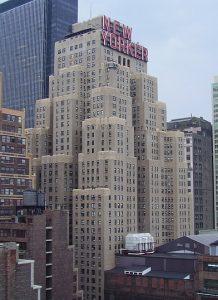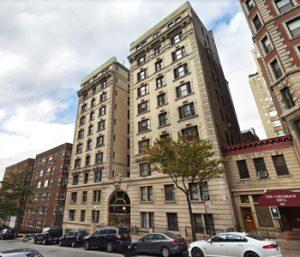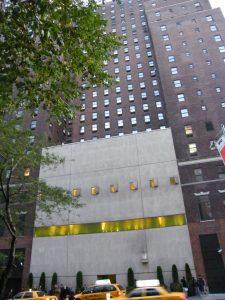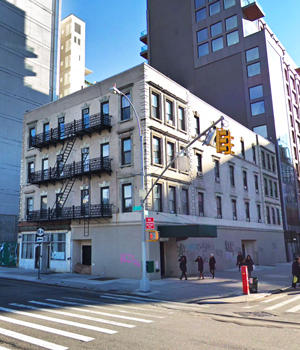In March 2009, a Queens woman checked into the Upper West Side’s Imperial Court Hotel for 10 nights. She requested a lease from management and became a permanent tenant. Her rent? Just $99 a week.
Flash forward to summer of 2015. A pair of taxi drivers checked into the Chelsea Highline Hotel for one night each, requested leases, and became permanent tenants for under $300 a month and free rent for life, respectively.
And in the wildest case yet, a recent transplant from Los Angeles checked into the New York Hotel in June 2018 for one night, requested a lease, and became a permanent tenant for a yet-to-be-determined rent. (He later became embroiled in a struggle for control of the entire hotel, but that’s another story.)
Every couple of years, an enterprising tenant will make New York real estate headlines by taking advantage of a “loophole” in rent stabilization law to score amazingly cheap rent at a hotel.
“Landlords like to complain that it’s a loophole, but it was a feature of the law from its conception,” said Larry Wood of the Goddard Riverside Law Project, a community organization that provides free legal services to low-income residents on the West Side of Manhattan.
“Meanwhile, a feature of the law that we didn’t like was the fact that you could rent units out legally on a transient basis to short term guests, and take it out of rent stabilization,” he added, referring to a widespread practice of registering units as “temporarily exempt due to transient occupancy,” which can lead to deregulation after a long enough period of time.
“We tried for years to close that loophole and were not successful, and landlords certainly were not successful in changing the law either.”

What is a “rent stabilized hotel”?
To put it simply, rent-stabilized hotels are those buildings whose rents are regulated by “hotel orders” from the Rent Guidelines Board — the same board that determines the amount by which rents at regulated apartments can be increased each year. Since 2012, the amount by which rent-stabilized hotels are allowed to increase rents each year has been… zero percent.

That’s probably the only simple thing about all this. The RGB’s hotel orders cover five different types of buildings — “Class A (apartment) hotels,” “lodging houses,” “rooming houses,” Class B hotels, and “Single Room Occupancy (SRO) buildings.”
Out of these five types, only Class A and Class B hotels are really what you would typically think of as a “hotel”, and that’s what we’ll be focusing on here. At the same time, the rules around all these types of dwellings essentially work in the same way.
How do rent-stabilized hotels work?
The way rent-stabilized hotels work — in theory — is outlined in the Notice of Rights that SRO hotel owners are supposed to provide to all tenants. Upon registration, any tenant has the right to “immediately request a lease to become a permanent tenant” and become protected by rent stabilization. Permanent tenants have the right to receive hotel services and cannot be evicted without a court order.
But things are a bit different in practice. First of all, housing advocates note that hotel owners universally ignore the obligation to provide the Notice of Rights to tenants, so many tenants are unaware of their right to permanent lease.
“I have never even once, in over a decade of working with affordable housing, seen an owner give this notice to a tenant,” said Brian Sullivan of legal services organization Mobilization for Justice.
Secondly, as you’ll notice from the news stories listed above, every time in recent memory a tenant has actually tried to use the “loophole,” they’ve ended up going to court.
“Normally the housing court gets the rules right, but it’s a real hassle for tenant. They might have to deal with an eviction, and it’s just stressful to have to deal with all that, so it really doesn’t happen very often,” Sullivan said, noting that the few cases that have made headlines represent nearly all cases of tenants successfully securing permanent tenancy at a rent-stabilized hotel.
Why are rent stabilized hotels a thing?

The story of rent-stabilized hotels is closely tied to the history of housing policy in New York City, dating all the way back to the Great Depression and the WWII era, when landlords began subdividing larger dwelling units into smaller SROs to meet booming demand from migrant workers, returning soldiers and immigrants. Many of these units were converted illegally, but changes to the city’s Multiple Dwelling Law legalized many SROs, provided that they met certain safety requirements.
In the decades following WWII, though, city policymakers began to see SROs as an undesirable form of housing. Through various measures such as a ban on SRO construction and tax incentives to encourage conversion to apartments, the city wiped out more than 100,000 SRO units between 1955 and 1985, contributing to a massive homelessness crisis. The SRO units that remained largely became housing of last resort for people on the verge of becoming homeless.
People who stay in SROs tend to be the most poor, the most vulnerable, and the most subject to landlord abuse, and so the code was written in a way that offers a really broad array of protections, Sullivan said.
Faced with these consequences, the city reversed its position on SROs in the 1980s, heavily restricting the conversion of SRO units and subjecting them to rent stabilization. After some back-and-forth in the courts that dragged on into the late 1990s, the current legal framework granting extensive protections to SRO residents eventually reached its current form.
“People who stay in SROs tend to be the most poor, the most vulnerable, and the most subject to landlord abuse, and so the code was written in a way that offers a really broad array of protections,” Sullivan said.
Where can I find a rent stabilized hotel? Asking for a friend.
This is a harder question to answer than you might think, thanks to a number of holes in enforcement and data collection. In fact, even the Rent Guidelines Board isn’t entirely sure how many rent-stabilized hotel units there are in the city.
“HCR [Department of Housing & Community Restoration] registration files provided to the RGB provide information only for hotel units that owners register, which may or may not accurately reflect the total number of units in the building,” the RGB’s explanatory statement to its most recent hotel order notes. And it gets better.
“For each hotel building, staff researched both registration records from the Department of Housing and Preservation Development (HPD), as well as internet sites, such as Expedia and Hotels.com, and the individual websites of the hotels, where available,” the statement continues. “In many cases, the unit count data from these different sources was inconsistent.”
Furthermore, even the legal definitions of basic concepts such as “single-room occupancy” and “hotel” are somewhat iffy, and many of the buildings in question are so old that they don’t have certificates of occupancy. Whether or not a hotel is subject to rent stabilization is also determined by the rent it was charging as of May 31, 1968 — not exactly a readily available statistic.
The analysis found 51 rent-stabilized hotels in Manhattan containing a total of more than 13,000 residential units, of which just 3,865 were rent-stabilized as of 2017.
To produce the map above, TRD’s analysis ultimately had to rely on DHCR’s list of rent-stabilized buildings — a flawed data source, but still the best option. These were then cross-referenced with registration data from HPD and historical tax bills which show the number of registered rent-stabilized units in each property.
The analysis found 51 rent-stabilized hotels in Manhattan containing a total of more than 13,000 residential units, of which just 3,865 were rent-stabilized as of 2017. This includes only those rent-stabilized buildings labeled as “hotel” in DHCR’s building list, and excludes “rooming houses” and other types of SROs.
The largest rent-stabilized hotel in the city happens to be one that recently made headlines — the New Yorker Hotel at 481 Eighth Avenue, owned by the Holy Spirit Association for the Unification of World Christianity.
Strangely, although this building appears in DHCR’s list of rent-stabilized buildings, the hotel’s tax bills (which consider the property a “house of worship,” by the way) show zero rent-stabilized units. Nevertheless, documents from an unrelated court case show that the hotel does in fact have 17 SRO tenants, not including Mickey Barreto, who recently tried to take over the whole hotel.
In general, TRD’s analysis found that many rent-stabilized hotels saw significant drops in the number of rent-stabilized units over the last decade, with many hotel shedding hundreds of units between 2007 and 2017.

The Hudson Hotel at 353 West 57th Street (Credit: Wikipedia)
For example, at the second-largest rent-stabilized hotel in the city, SBE Entertainment Group’s Hudson Hotel at 353 West 57th Street, tax bills show that the property had 103 rent-stabilized units in 2007, but just 49 now.
According to a report from Kroll Bond Rating Agency, these units are located on the 20th and 21st floors of the hotel and are served by a separate entrance and elevator bank. “The sponsor has converted 64 SROs to guest rooms through natural attrition (without buyouts) since 2000, and plans to convert the remaining units to guest rooms when an entire floor becomes available,” the report notes. Unless someone new moves in and requests a permanent tenant lease, presumably.
Owners realized that they could just bide their time and not rent to new tenants.
“That’s totally consistent with what we’ve seen,” Goddard Riverside Law Project’s Wood said of the decrease in stabilized units, a large part of which has simply come from natural attrition as tenants move (or pass) away. “Owners realized that they could just bide their time and not rent to new tenants.”
Rent-stabilized hotel owners have also sometimes resorted to harassment (“but not as much as in the bad old days of the 1980s”) or buyouts (“$5,000 looks like a lot when you’re living hand-to-mouth”) to free up rent-stabilized units for more profitable ends, Wood added. And in other cases, hotel owners may simply not be registering their rent-stabilized units.
Rent stabilization law saw some big changes recently. Are hotels affected?
For the most part, rent-stabilized hotel law is already so much more radically pro-tenant than apartment law that the latest developments in Albany have had little impact on rent-stabilized hotels. Except for one change, which could have complicated consequences for hotels.
According to the new rent law, the look-back period for rent overcharge claims has been extended from four years to six, “or more years as reasonably necessary to determine a reliable base rent.” This has the potential to become particularly problematic for hotel units, whose rent histories tend to be cloudier than is the case for apartments.

The Chelsea Highline Hotel at 184 11th Avenue (Credit: Google Maps)
For example, one of the taxi drivers who checked into the Chelsea Highline hotel in 2015 was originally able to get free rent thanks to the lack of a reliable rent history for the unit he was staying in, though this was eventually increased to $234 by DHCR using a formula based on the rent being charged on other units in the building — and the tenant is currently suing to bring that down to $83. An indefinite look-back period could potentially make the process of determining the legal rent at a rent-stabilized hotel even more complicated.
“Now it’s going to be open — the way the law works now is that you go to the last reliable rent, and exactly what ‘reliable’ means is going to be tested over the next few years,” Sullivan said. “So as a tenant advocate I would look at it and try to identify fraud going five years back, maybe 10 years back, or maybe all the way back to 1984, and I’d say that’s when the last reliable rent was registered.”
“Who knows whether I’d win that argument or not, but the law has been expanded a lot,” he concluded.
Correction: The occupant at the Imperial Court Hotel paid $99 a week in rent, not a month.
